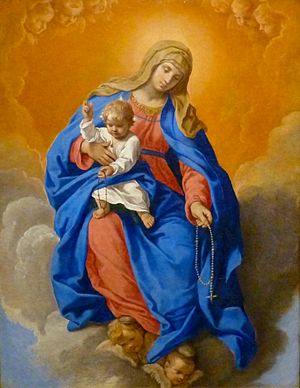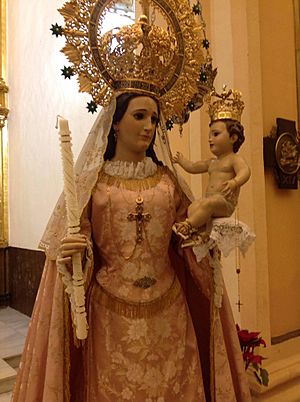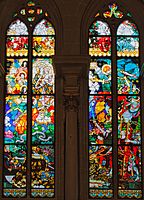Our Lady of the Rosary facts for kids
Quick facts for kids Our Lady of the Rosary |
|
|---|---|
 |
|
| Our Lady of Victory, Our Lady of the Most Holy Rosary | |
| Venerated in | Roman Catholic Church |
| Major shrine | Our Lady of Victory Basilica, Basilica of Notre-Dame-des-Victoires, Paris |
| Feast | 7 October |
| Attributes | Blessed Virgin Mary, Infant Jesus, crown, rosary |
| Patronage | Rosary, Roman Catholic Diocese of Malaga, Toledo, Rosario, Santa Fe, Rosario, Cavite, Roman Catholic Diocese of San Nicolás de los Arroyos, Santos, Melilla, Trujillo, Cáceres, Colombia, Manizales, Puyo, Pastaza, North Carolina, Bohol, Guatemala, Surigao del Norte, Manila, Quezon City, West Virginia, Seseña, Ontígola, Olías del Rey, Montearagón, Toledo, Lagartera, Huerta de Valdecarábanos, Brenes, Palma Cuata, Zacatecas Lima, Peru |
|
Tradition or genre
|
Marian apparition |
Our Lady of the Rosary, also known as Our Lady of the Holy Rosary, is a special title given to Mary, the mother of Jesus. This title is linked to the rosary, a special set of prayers.
The Feast of Our Lady of the Rosary is celebrated every year on October 7th. This date remembers a very important victory in history. On October 7, 1571, a group of Christian fleets won a big battle against the Ottoman navy. This victory is known as the Battle of Lepanto.

Contents
The Story of the Rosary
According to a tradition from the Dominican religious order, the rosary was given to Dominic de Guzmán in 1206. He was in France, trying to help people return to the Catholic faith. The story says that Mary appeared to him and gave him the rosary. She told him it would be a powerful tool to help people.
While this story is a legend, the rosary prayer did become very popular thanks to the followers of Saint Dominic. A priest named Alanus de Rupe in the 1400s also helped spread the rosary.
Our Lady of Victory and the Battle of Lepanto
In 1571, Pope Pius V brought together a group of Christian forces. These forces came from Spain and other Christian kingdoms. Their goal was to help Christian areas in Cyprus that were under attack.
On October 7, 1571, this group, called the Holy League, met a strong Ottoman fleet. This happened during the Battle of Lepanto. The Christian forces were not as strong as the Ottoman navy. Because of this, Pope Pius V asked all of Europe to pray the Rosary for victory. He even led a rosary procession in Rome.
After about five hours of fighting, the Christian navies won. They stopped the Ottoman navy from moving further west. This victory was very important. If the Ottomans had won, they might have invaded Italy. The Ottoman Empire was able to build more ships later. But they never fully recovered from losing so many trained sailors. They were no longer the powerful navy they had been in the Mediterranean Sea.
Our Lady of Fátima
The famous Marian apparition in Fátima, Portugal, is also known as Our Lady of the Holy Rosary of Fátima. In 1917, Mary appeared to three young children: Jacinta Marto, Lucia dos Santos, and Francisco Marto.
She asked them to "pray the Rosary every day." She said this would help bring peace to the world and end the war.
Celebrating the Feast Day
Pope Pius V created the feast of Our Lady of Victory to remember the win at Lepanto. He believed Mary helped them win. Before this, some places already honored Our Lady of Victory. For example, in 1213, Simon de Montfort, 5th Earl of Leicester built a shrine to Our Lady of Victory. This was after a Catholic victory in the Battle of Muret.
In 1573, Pope Gregory XIII changed the name of the feast to Feast of the Holy Rosary. It was celebrated on the first Sunday of October. Later, in 1716, Pope Clement XI made the feast of the Rosary a celebration for the whole universal Church. This was after another victory over the Turks.
Pope Leo XIII made the feast even more important. He also added the prayer "Queen of the Most Holy Rosary" to the Litany of Loreto.
In 1913, Pope Pius X moved the date to October 7th. This is the date we celebrate it today. In 1969, Pope Paul VI made "Our Lady of the Rosary" a mandatory memorial. This means it must be remembered in Catholic churches.
-
Our Lady of Victory by Józef Mehoffer, 1896–1897, stained glass window in Fribourg Cathedral
Patronage
Our Lady of the Rosary is the patron saint of many places around the world. For example, the Diocese of Malaga in Spain honors her. The Spanish cities of Melilla and Trujillo also celebrate Our Lady of Victory as their patroness.
The name María del Rosario is a common female Spanish name. People often shorten it to Rosario or Charo. Rosario can also be a male name, especially in Italy.
Churches Dedicated to Our Lady of the Rosary
Many churches are named after Our Lady of the Rosary.
- The Basilica of Our Lady of the Rosary is in Fátima, Portugal. It is part of the famous Marian Shrine.
- The Chapel of the Virgin of the Rosary in Puebla City, Mexico, is very famous. It was built between 1531 and 1690. People once called it the "Eighth Wonder of the World."
- The cathedral for the Diocese of Toledo in Ohio is named after Our Lady of the Rosary. So are the cathedrals in Duluth, Minnesota, and San Bernardino.
- The church of Our Lady of the Rosary in New York City started in 1883. It helped Irish immigrant girls.
- There is a large church in Jashpur, Chhattisgarh, India, called Our Lady of the Rosary. It is the second largest church in Asia by seating capacity. It can hold 10,000 worshippers.
- The Metropolitan Cathedral of Our Lady of the Holy Rosary is in Vancouver, Canada.
- St Dominic's Priory Church in London has a shrine to Our Lady of the Rosary.
Churches Named for Our Lady of Victory
Even though the name "Our Lady of the Rosary" is more common now, "Our Lady of Victory" is still used. Many churches and schools use this older title.
- Notre-Dame-des-Victoires, Paris is a historic shrine in France. It was built in 1629. King Louis XIII named it to thank Mary for a French victory.
- The Church of Our Lady of Victory in Prague has the famous 16th-century Infant Jesus of Prague statue.
- Notre-Dame-des-Victoires, San Francisco was founded in 1856. It served French Catholic immigrants. It was rebuilt in 1915 after an earthquake.
- Our Lady of Victory National Shrine and Basilica is in Lackawanna, New York.
- Our Lady of Victory is the main church for the Diocese of Victoria, Texas.
- The church of Our Lady of Victory in Manhattan, New York City, was dedicated in 1947. It honors soldiers who fought in World War II.
- The chapel at St. Catherine University in St. Paul, Minnesota, is named for Our Lady of Victory.
- St. Mary of Victories Hungarian Catholic Church is in St. Louis, Missouri. It is one of the oldest Catholic churches in the city.
- Our Lady of Victories in Kensington, London, was heavily bombed during World War II.
- The Chapel of Our Lady of Victory is an old chapel in São Francisco do Conde, Brazil.
See also
 In Spanish: Virgen del Rosario para niños
In Spanish: Virgen del Rosario para niños


